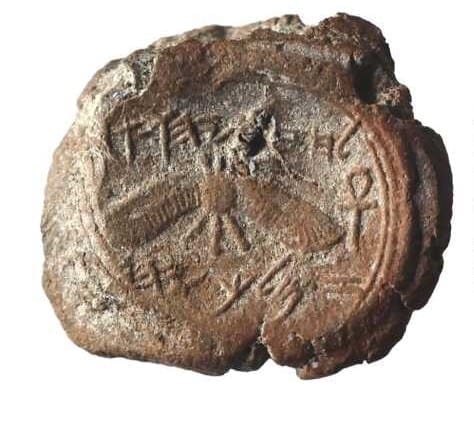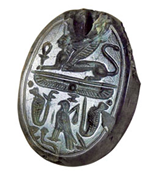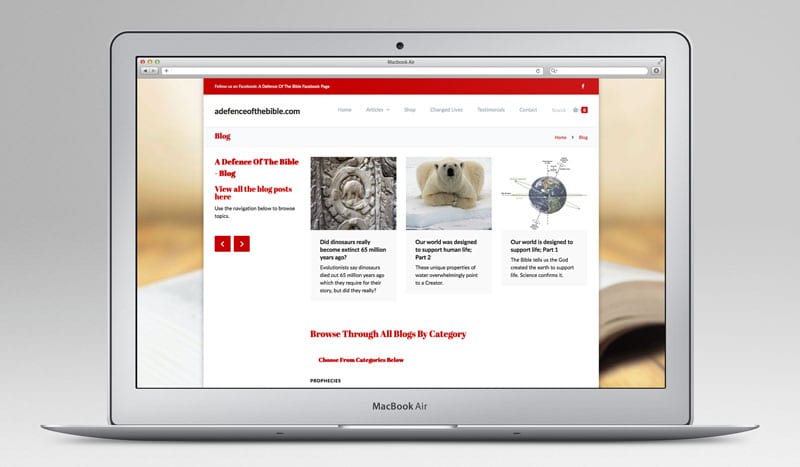Introduction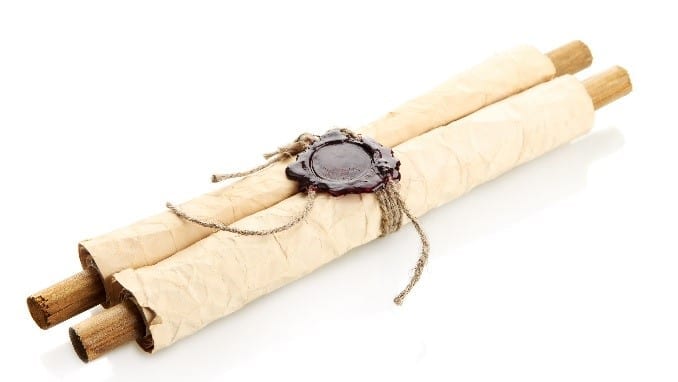
As papyrus and parchment gradually replaced clay tablets and as societies grew more sophisticated, the need to protect the contents of documents became important, the seal satisfied this need. The seal, or signet, protected scrolls from tampering as shown. In some cases, documents were perforated and the binding material threaded through to prevent it from being removed without breaking the seal.[1]
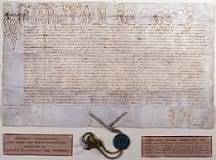 Seals, (Latin bulla, plural bullae), were used to protect and provide authenticity of a document, hence the term “Papal Bull” refers to a sealed statement from the pope. One is shown. The instrument for making the impression was generally a stone, in some cases a precious stone, or metal, commonly set in a ring worn on the figure with a distinctive design carved into it identifying the person and his/her title. Soft clay would be placed on the string and an impression made with the signet ring, registering the authority of the person who owned the ring.
Seals, (Latin bulla, plural bullae), were used to protect and provide authenticity of a document, hence the term “Papal Bull” refers to a sealed statement from the pope. One is shown. The instrument for making the impression was generally a stone, in some cases a precious stone, or metal, commonly set in a ring worn on the figure with a distinctive design carved into it identifying the person and his/her title. Soft clay would be placed on the string and an impression made with the signet ring, registering the authority of the person who owned the ring.
The use of seals is mentioned many times in the Bible,[2] two examples are given:
1 Kings 21:8 referring to Jezebel; So she wrote letters in Ahab’s name and sealed them with his seal and sent letters to the elders and to the nobles who were living with Naboth in his city.
Daniel 6:17; A stone was brought and laid over the mouth of the den; and the king sealed it with his own signet ring and with the signet rings of his nobles, so that nothing would be changed in regard to Daniel.
So, not only kings had seals, so did nobles and anybody in a position of authority as confirmed by archaeology.
When a city was destroyed by fire, as happened to Jerusalem at the hands of the Babylonians in 586 BC, the scrolls would be burnt, but the clay seals would only become harder and more durable. Jeremiah was a prophet during this destructive period of Judah’s history and many of the seals recovered authenticate the people and their positions who were living prior to and during this time.
Examples of personal seals which verified the people of the Bible
Kings and Queens
King Ahaz
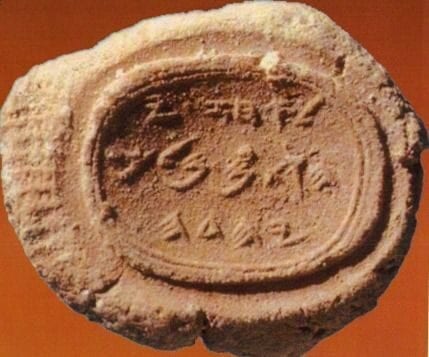 Ahaz was a king of Judah (c. 735–720 bc) who became an Assyrian vassal (2 Kings 16; Isaiah 7–8). His seal originating from 8th century BC and the place of discovery of this seal is unknown. It is currently part of Shlomo Moussaieff’s private collection. The seal contains an ancient Hebrew inscription mentioning the name of Ahaz of Judah, as well as the name of his father, Yehotam (Jotham), identifying Ahaz as the “King of Judah”. As can be seen, the bulla contains a fingerprint which may belong to Ahaz himself.
Ahaz was a king of Judah (c. 735–720 bc) who became an Assyrian vassal (2 Kings 16; Isaiah 7–8). His seal originating from 8th century BC and the place of discovery of this seal is unknown. It is currently part of Shlomo Moussaieff’s private collection. The seal contains an ancient Hebrew inscription mentioning the name of Ahaz of Judah, as well as the name of his father, Yehotam (Jotham), identifying Ahaz as the “King of Judah”. As can be seen, the bulla contains a fingerprint which may belong to Ahaz himself.
Also, the seal positively identifies king Jotham. He became king of Judah at age twenty-five and reigned for sixteen years, from 750 to 735 BC (2 Kings 15:33; 2 Chronicles 27:1)
The Hebrew University of Jerusalem announced a significant discovery on December 2, 2015; the first seal impression of a Judahite king ever found by archaeologists during an archaeological dig, in Jerusalem.
The impression says, “Belonging to Hezekiah [son of] Ahaz, king of Judah.”
Although seal impressions bearing King Hezekiah’s name have already been known from the antiquities market since the middle of the 1990s—some with a winged scarab (dung beetle) symbol, and others with a winged sun; this is the first time that a seal impression of the Judean king has ever come to light in a scientific archaeological excavation, Dr Eilat Mazar said in the Hebrew University press release.
King Manasseh
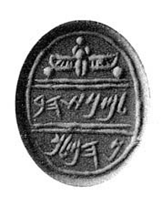 Two seals have appeared on the antiquities market, both bearing the inscription, “Belonging to Manasseh, son of the king.” The term “son of the king” refers to royal princes, whether they eventually ascended the throne or not. While it is doubtful that one of the seals (bearing a star and crescent) refers to the King Manasseh, the other may be the seal that Manasseh used during his co-regency with his father. In the Corpus of Western Semitic Stamp Seals, Nahman Avigad concluded, “a thorough microscopic examination of the stone revealed that the engraving does not give the impression of being recent. Moreover, the script, showing a fluent classic Hebrew hand, appears to be authentic in form and spirit.” Interestingly, it bears the same iconography; the Egyptian winged scarab, as that of numerous seals attributed to King Hezekiah.[3]
Two seals have appeared on the antiquities market, both bearing the inscription, “Belonging to Manasseh, son of the king.” The term “son of the king” refers to royal princes, whether they eventually ascended the throne or not. While it is doubtful that one of the seals (bearing a star and crescent) refers to the King Manasseh, the other may be the seal that Manasseh used during his co-regency with his father. In the Corpus of Western Semitic Stamp Seals, Nahman Avigad concluded, “a thorough microscopic examination of the stone revealed that the engraving does not give the impression of being recent. Moreover, the script, showing a fluent classic Hebrew hand, appears to be authentic in form and spirit.” Interestingly, it bears the same iconography; the Egyptian winged scarab, as that of numerous seals attributed to King Hezekiah.[3]
Jezebel, was the wicked wife of king Ahab of the northern kingdom. She was the daughter of Ithobaal I of Tyre. Her seal was discovered in 1964 and interpreted by Prof Marjo Korpel a Utrecht University Old Testament scholar, who confirmed it to be the seal of Ahab’s wife; the wicked Queen Jezebel. Although this assignment was initially questioned, it seems that there is now a consensus of support.[4] Jezebel is featured in 1 Kings chapters 16-22.
Pedaiah son of Jehoiachin
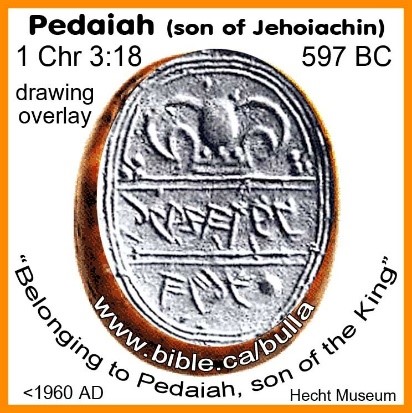 A seal inscribed “belonging to Pedaiah son of the king” Pedaiah was the son of Jehoichin, and therefore in the Royal line of Judah. 1 Chronicles 3:16-19 state,[5]
A seal inscribed “belonging to Pedaiah son of the king” Pedaiah was the son of Jehoichin, and therefore in the Royal line of Judah. 1 Chronicles 3:16-19 state,[5]
The successors of Jehoiakim were his son Jehoiachin and his brother Zedekiah. The sons of Jehoiachin, who was taken prisoner by the Babylonians, were Shealtiel, Malkiram, Pedaiah, Shenazzar, Jekamiah, Hoshama, and Nedabiah. The sons of Pedaiah were Zerubbabel and Shimei.
Iikar son of Zedekiah
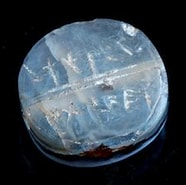 Inscribed with the words “Belonging to Ikar, son of Mattaniah,” this early sixth-century BC seal was found in 2019 in the Givati Parking Lot excavations. It is a beautiful semi-transparent blue stone seal with a rather innocuous inscription. But behind this pretty seal may lie a dark event. The name Zedekiah was given to the king by Nebuchadnezzar. Zedekiah’s original name was Mattaniah (2 Kings 24:17). Thus, this seal—fitting with the location, dating and father’s name—may well have belonged to one of the king’s sons; a son subsequently executed by Nebuchadnezzar.[6]
Inscribed with the words “Belonging to Ikar, son of Mattaniah,” this early sixth-century BC seal was found in 2019 in the Givati Parking Lot excavations. It is a beautiful semi-transparent blue stone seal with a rather innocuous inscription. But behind this pretty seal may lie a dark event. The name Zedekiah was given to the king by Nebuchadnezzar. Zedekiah’s original name was Mattaniah (2 Kings 24:17). Thus, this seal—fitting with the location, dating and father’s name—may well have belonged to one of the king’s sons; a son subsequently executed by Nebuchadnezzar.[6]
King Jeroboam’s servant
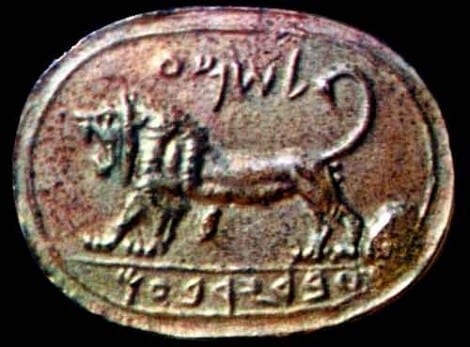 This seal was discovered in 1904 during the earliest excavation of Megiddo, led by Gottlieb Schumacher and is a seal belonging to a royal minister in the 8th century BC. It is engraved with the figure of a roaring lion, symbol of the kingdom of Judah with a beautiful curved tail skilfully fashioned. The inscription reads “Shema” on top, and “Servant of Jeroboam” on the bottom. Jeroboam II was king of the northern kingdom and his name and position validated by this seal. He is mentioned in 1 Kings 11 and 2 Chronicles 10.
This seal was discovered in 1904 during the earliest excavation of Megiddo, led by Gottlieb Schumacher and is a seal belonging to a royal minister in the 8th century BC. It is engraved with the figure of a roaring lion, symbol of the kingdom of Judah with a beautiful curved tail skilfully fashioned. The inscription reads “Shema” on top, and “Servant of Jeroboam” on the bottom. Jeroboam II was king of the northern kingdom and his name and position validated by this seal. He is mentioned in 1 Kings 11 and 2 Chronicles 10.
Seals of people associated with Jeremiah
Seal of Baruch Jeremiah’s scribe
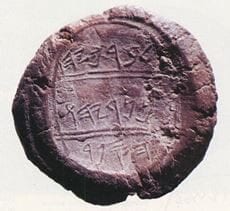 Known as the Baruch Bulla, it was discovered in 1975 and was studied by Israeli archaeologist Nahman Avigad. The three lines on the Baruch bulla read: “(Belonging) to Berekhyahu, the son of Neriyahu, the scribe.” The suffix -yahu was a common epithet attached to names in Judah, meaning, “blessed of Jehovah.” While translations sometimes render it “-iah” (cf. Baruch’s father Ner-iah), some texts drop it altogether. This bulla is now displayed in the Israel Museum in Jerusalem. The inscription reads, “Berekhyahu son of Neriyahu the scribe.” Baruch’s full name was Berekhyahu, meaning “the blessed of Yahweh.”
Known as the Baruch Bulla, it was discovered in 1975 and was studied by Israeli archaeologist Nahman Avigad. The three lines on the Baruch bulla read: “(Belonging) to Berekhyahu, the son of Neriyahu, the scribe.” The suffix -yahu was a common epithet attached to names in Judah, meaning, “blessed of Jehovah.” While translations sometimes render it “-iah” (cf. Baruch’s father Ner-iah), some texts drop it altogether. This bulla is now displayed in the Israel Museum in Jerusalem. The inscription reads, “Berekhyahu son of Neriyahu the scribe.” Baruch’s full name was Berekhyahu, meaning “the blessed of Yahweh.”
Jeremiah 32:10-12 states:
10 I signed and sealed the deed, had it witnessed, and weighed out the silver on the scales. I took the deed of purchase—the sealed copy containing the terms and conditions, as well as the unsealed copy— 12 and I gave this deed to Baruch son of Neriah, the son of Mahseiah, in the presence of my cousin Hanamel and of the witnesses who had signed the deed and of all the Jews sitting in the courtyard of the guard.
Seriah
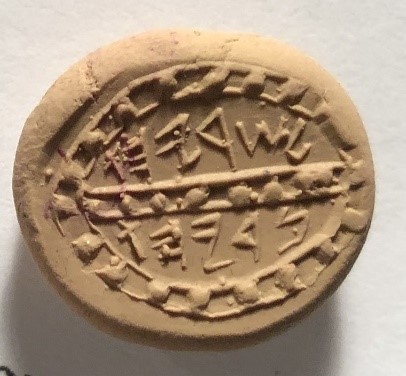 Seraiah’s seal has also been found, it is inscribed with the following words: “Seriahu, son of Neriahu .” He was the brother of Baruch, the scribe of the prophet Jeremiah. He served as quartermaster when he accompanied King Zedekiah of Judah on a journey to Babylon (Jeremiah 51:59). Before Seriah left, Jeremiah instructed him to take a book of Jeremiah’s prophecies concerning Babylon and read it to the Babylonians, and then to, Bind a stone to it, and cast it into the midst of the Euphrates, and say ‘Thus shall Babylon sink and never rise again’ (Jeremiah 51:63–64).
Seraiah’s seal has also been found, it is inscribed with the following words: “Seriahu, son of Neriahu .” He was the brother of Baruch, the scribe of the prophet Jeremiah. He served as quartermaster when he accompanied King Zedekiah of Judah on a journey to Babylon (Jeremiah 51:59). Before Seriah left, Jeremiah instructed him to take a book of Jeremiah’s prophecies concerning Babylon and read it to the Babylonians, and then to, Bind a stone to it, and cast it into the midst of the Euphrates, and say ‘Thus shall Babylon sink and never rise again’ (Jeremiah 51:63–64).
Jehucal
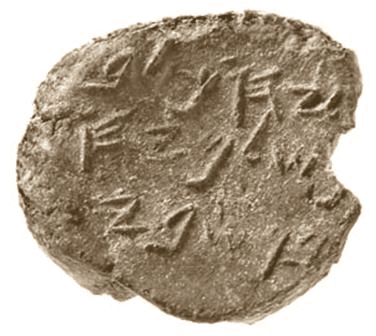 While Jerusalem was under siege from the Babylonians (588-586 BC), Jeremiah urged the people to surrender and live, while those who do not will die. This was a message he received from God.[7] As a consequence, some of King Zedekiah’s courtiers took Jeremiah and threw him into a cistern which was empty, although Jeremiah did sink into the mud. Two of these courtiers were Jehucal son of Shelemiah and Gedaliah son of Pashur.[8]
While Jerusalem was under siege from the Babylonians (588-586 BC), Jeremiah urged the people to surrender and live, while those who do not will die. This was a message he received from God.[7] As a consequence, some of King Zedekiah’s courtiers took Jeremiah and threw him into a cistern which was empty, although Jeremiah did sink into the mud. Two of these courtiers were Jehucal son of Shelemiah and Gedaliah son of Pashur.[8]
In 2005 archeologist Dr Eilat Mazar of the Hebrew University of Jerusalem discovered a clay seal when she was digging near the Dung Gate of the Old City. It was dated to the sixth century BC and the Paleo-Hebrew writing on it was translated as: belonging to Jehucal son of Shelemiah son of Shovi.
This seal confirms the existence of Shelemiah, who was one of Zedekiah’s officials (Jeremiah 37:3; 38:1).
Gedaliah
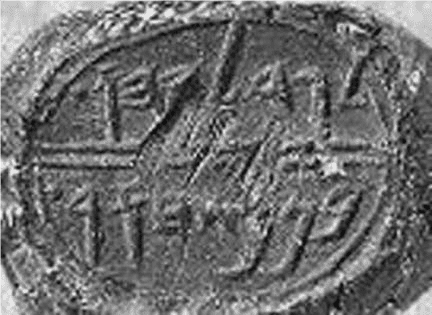 While digging further in 2008 in the same area, Dr Mazar discovered another seal also dated to the sixth century BC, this time with the inscription: Gedaliah son of Pashur.
While digging further in 2008 in the same area, Dr Mazar discovered another seal also dated to the sixth century BC, this time with the inscription: Gedaliah son of Pashur.
As well, the inscription confirms the identity of Pashur who is described as being one of Zedekiah’s officials. Jeremiah 38:1 states:
Shephatiah son of Mattan, Gedaliah son of Pashhur, Jehukal son of Shelemiah, and Pashhur son of Malkijah heard what Jeremiah was telling all the people when he said,
The significance of these seals is that they confirm the reliability and accuracy of the Bible even down to the names of the king’s officials.[9]
The high priestly family
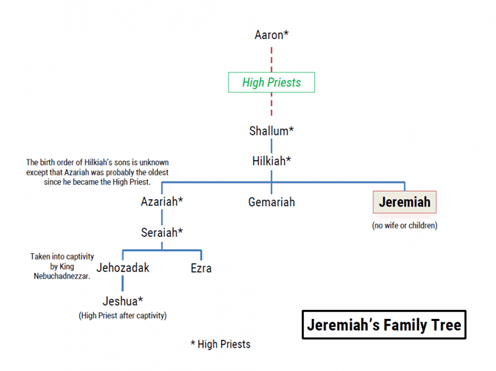 Azariah son of high priest Hilkiah
Azariah son of high priest Hilkiah
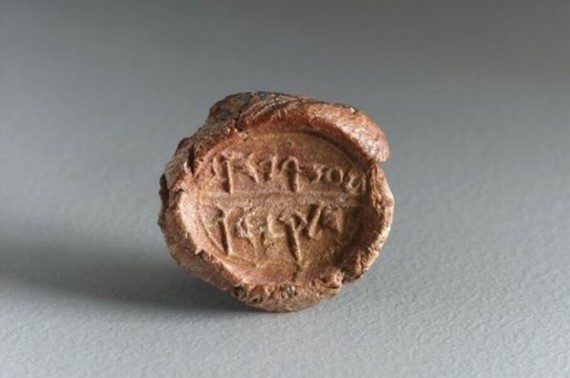 Israeli archaeologist Yigal Shiloh uncovered 51 bullae (clay seals) in 1982. One of the notable bulla, measuring just under a centimeter in diameter, contained two lines of ancient Hebrew text. The inscription reads “Belonging to Azariah, son of Hilkiah.” He is mentioned in 1Chronicles 6:13 as part of the generations of Levi:
Israeli archaeologist Yigal Shiloh uncovered 51 bullae (clay seals) in 1982. One of the notable bulla, measuring just under a centimeter in diameter, contained two lines of ancient Hebrew text. The inscription reads “Belonging to Azariah, son of Hilkiah.” He is mentioned in 1Chronicles 6:13 as part of the generations of Levi:
Shallum the father of Hilkiah, Hilkiah the father of Azariah.
When Hilkiah went into the temple to collect the money for the repairs, he found the Book of the Law of the LORD that had been given through Moses. Hilkiah gave the Book to Shaphan who read it to King Josiah (2 Kings 22:11-13).
This seal also confirms the reality of the high priest Hilkiah.
Hanan
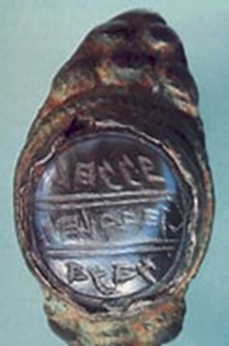 In 1980, a seal inscribed with the text “Belonging to Hanan, son of Hilkiah the Priest” was acquired on the antiquities market. Although it was not discovered in situ, there is little doubt as to its authenticity. While the Bible does not identify a “Hanan, son of Hilkiah,” experts who have analyzed this seal highlight script similarities with the “Azariah, son of Hilkiah” bulla, and conclude that the seal was most likely made by the same craftsman. As such, this may refer to the same Hilkiah, the high priest—thus identifying Hanan as another son. Again, this seal may also relate to Jeremiah’s father “Hilkiah the priest.” inscribed with the text “Belonging to Gemariah, son of Shaphan,” this bulla was also discovered during Shiloh’s 1982 City of David excavations. It was found along with the “Azariah, son of Hilkiah” bulla. In fact, these were part of a huge trove of 51 bullae discovered in a sixth-century BC building located at the base of the Stepped Stone Structure. This building became known as the “House of Bullae.”
In 1980, a seal inscribed with the text “Belonging to Hanan, son of Hilkiah the Priest” was acquired on the antiquities market. Although it was not discovered in situ, there is little doubt as to its authenticity. While the Bible does not identify a “Hanan, son of Hilkiah,” experts who have analyzed this seal highlight script similarities with the “Azariah, son of Hilkiah” bulla, and conclude that the seal was most likely made by the same craftsman. As such, this may refer to the same Hilkiah, the high priest—thus identifying Hanan as another son. Again, this seal may also relate to Jeremiah’s father “Hilkiah the priest.” inscribed with the text “Belonging to Gemariah, son of Shaphan,” this bulla was also discovered during Shiloh’s 1982 City of David excavations. It was found along with the “Azariah, son of Hilkiah” bulla. In fact, these were part of a huge trove of 51 bullae discovered in a sixth-century BC building located at the base of the Stepped Stone Structure. This building became known as the “House of Bullae.”
Gemariah
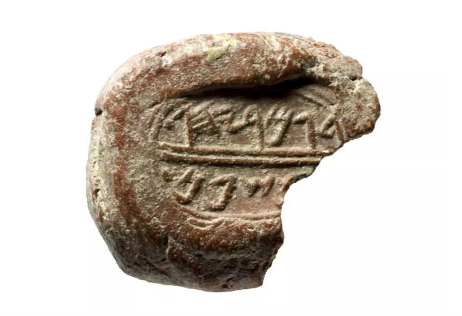 Jeremiah chapter 36 reveals that the prophet had been put under house arrest and his scribe, Baruch, had to deliver the prophecies in the temple grounds. Verse 10 states, From the room of Gemariah son of Shaphan the secretary, which was in the upper courtyard at the entrance of the New Gate of the temple, Baruch read to all the people at the LORD’s temple the words of Jeremiah from the scroll. Verse 12, he went down to the secretary’s room in the royal palace, where all the officials were sitting: Elishama the secretary, Delaiah son of Shemaiah, Elnathan son of Akbor, Gemariah son of Shaphan, Zedekiah son of Hananiah, and all the other officials.
Jeremiah chapter 36 reveals that the prophet had been put under house arrest and his scribe, Baruch, had to deliver the prophecies in the temple grounds. Verse 10 states, From the room of Gemariah son of Shaphan the secretary, which was in the upper courtyard at the entrance of the New Gate of the temple, Baruch read to all the people at the LORD’s temple the words of Jeremiah from the scroll. Verse 12, he went down to the secretary’s room in the royal palace, where all the officials were sitting: Elishama the secretary, Delaiah son of Shemaiah, Elnathan son of Akbor, Gemariah son of Shaphan, Zedekiah son of Hananiah, and all the other officials.
Hananiah
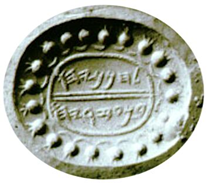 “Belonging to Hananiah, son of Azariah.” This seal was discovered on the antiquities market in 1982. It too, is considered to be authentic. Its ornate pomegranate border matches precisely with those discovered in excavations of this period, suggesting the work of the same engraver. Jeremiah 28 details one of Jeremiah’s opponents: the false prophet “Hananiah, son of Azur.” Azur is a short version of the name Azariah (again, the interchangeable theophoric “iah”).[10]
“Belonging to Hananiah, son of Azariah.” This seal was discovered on the antiquities market in 1982. It too, is considered to be authentic. Its ornate pomegranate border matches precisely with those discovered in excavations of this period, suggesting the work of the same engraver. Jeremiah 28 details one of Jeremiah’s opponents: the false prophet “Hananiah, son of Azur.” Azur is a short version of the name Azariah (again, the interchangeable theophoric “iah”).[10]
Elishama Seal
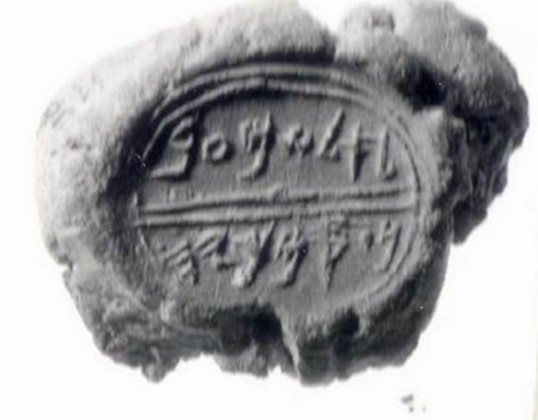 In 1975 a cache’ of 250 clay seals were found. Among them a clay seal was impressed with the name of the scribe Elishama. It reads as follows: ‘Elishama’ servant of the king.
In 1975 a cache’ of 250 clay seals were found. Among them a clay seal was impressed with the name of the scribe Elishama. It reads as follows: ‘Elishama’ servant of the king.
According to the Bible, Elishama was a scribe who served the king. He is recorded in Jeremiah 36:10-12:
Then Baruch read from the book the words of Jeremiah in the house of the LORD, in the chamber of Gemariah the son of Shaphan the scribe, in the upper court at the entry of the New Gate of the Lord’s house, in the hearing of all the people.
After Baruch read the prophecies in the Temple, an official requested the scroll be read, in the hearing of the king and in the hearing of all the princes [rulers] who stood beside the king” (Jer. 36:21). This included Elishama the scribe.
Baruch left the scroll for safekeeping in Elishama’s manuscript chamber. Later the king had someone fetch the scroll and read it before him. Elishama probably saw the king desecrate the document (vv. 11–23).
The episode closes with, Yet they were not afraid, nor did they tear their garments, the king nor any of his servants who heard all these words” (v. 24). Unlike Gemariah and others, Elishama, servant of the king did not beg the king to stop his sacrilege.
Nathan-Melech
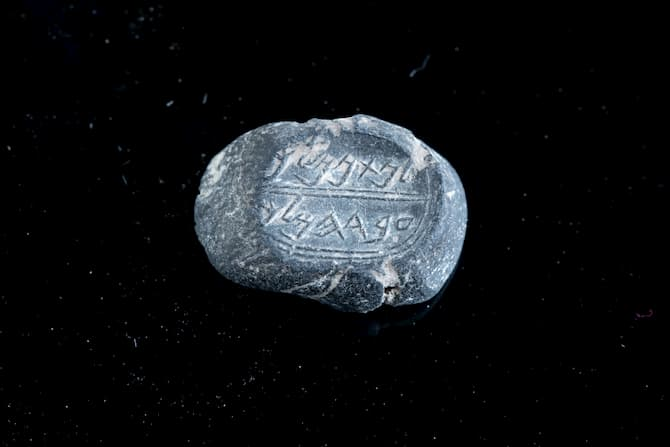
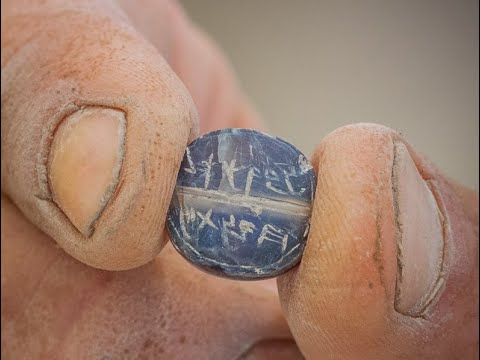 In March 2019, archaeologists discovered not only a seal but also the stamp that formed it (pictured left.) The finds were made by a team from the Israel Antiquities Authority and Tel Aviv University that was excavating beneath the former Givati parking lot in Jerusalem, just south of the Temple Mount. The seal impression is pictured right. Its inscription when translated reads; to Nathan-Melech, the king’s servant. Nathan-Melech is a name that appears only once in the Bible, 2 Kings 23:11,
In March 2019, archaeologists discovered not only a seal but also the stamp that formed it (pictured left.) The finds were made by a team from the Israel Antiquities Authority and Tel Aviv University that was excavating beneath the former Givati parking lot in Jerusalem, just south of the Temple Mount. The seal impression is pictured right. Its inscription when translated reads; to Nathan-Melech, the king’s servant. Nathan-Melech is a name that appears only once in the Bible, 2 Kings 23:11,
He (Josiah) removed from the entrance to the temple of the Lord the horses that the kings of Judah had dedicated to the sun. They were in the court near the room of an official named Nathan-Melech. Josiah then burned the chariots dedicated to the sun.
Dr. Yiftach Shalev of the IAA, said he needed only a few minutes to read the ancient Hebrew on the clay bulla, which dates to the middle of the seventh or beginning of the sixth century B.C., judging by the style of writing on it and the pottery found next to it. All of this tie in beautifully with Nathan-Melech being the servant of Judahite king Josiah and the sacking of Jerusalem in 586 BC by the Babylonians.
Bethlehem bulla
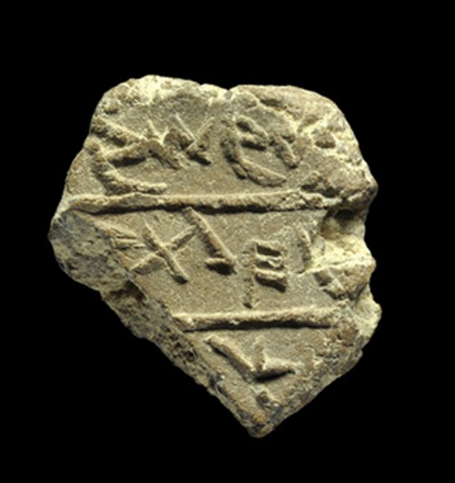 A 2,500 year old clay bulla, or seal, inscribed with the name Bethlehem, the only known ancient reference to the city found outside the Bible. (Israel Antiquities Authority / May 23, 2012).
A 2,500 year old clay bulla, or seal, inscribed with the name Bethlehem, the only known ancient reference to the city found outside the Bible. (Israel Antiquities Authority / May 23, 2012).
The bulla dates to the First Temple period (1006 – 586 BC) and is carved with three important lines of ancient Hebrew script.
The first says “in the seventh;” the second says Bethlehem; and the third has the letter “ch,” which was probably the last letter of melech, the word for king.
Conclusion
These seals have identified 19 people mentioned in the Bible from the time of the Babylonian destruction of Jerusalem in 586 BC. They have not only identified their names, but their positions and the period during which they lived as well. They are just more pieces of evidence that are added to the ever-growing mountain that supports the integrity of the Bible. For a list of 83 people mentioned in the Bible who have been confirmed from sources outside of the Bible, go to: https://www.adefenceofthebible.com/2017/06/26/confirmation-of-83-people-mentioned-in-the-bible.
Evidence from science, archaeology and ancient texts shows that the Bible is unique in all ancient literature. The people were real, the places mentioned really existed and the events described between its pages happened. This provides enormous confidence for us to believe the things in the Bible that cannot be tested like the sinfulness of mankind and the fact that the Creator of the heavens and of all life, left His glory on high to be born a mere man to live among His people and to pay the penalty for the sins of the world, so that all who really believe may have eternal life with Him.
[1] https://en.wikipedia.org/wiki/Bulla_(seal)#Clay_bullae_as_seals.
[2] Genesis 38:18; 41:42; Job 38:14; 1 Kings 21:8; Ester 3:12; 8:8; Jerimiah 32:11-14; Nehemiah 9:38; 10:1; and Revelation 5:1-5.
[3] https://biblearchaeologyreport.com/2021/02/12/king-manasseh-an-archaeological-biography.
[6] Ibid.
[7] Jeremiah 38:2.
[8] Jeremiah 38:1.
[9] Both images are courtesy of Generation Word (generationword.com).
[10] Ibid.
